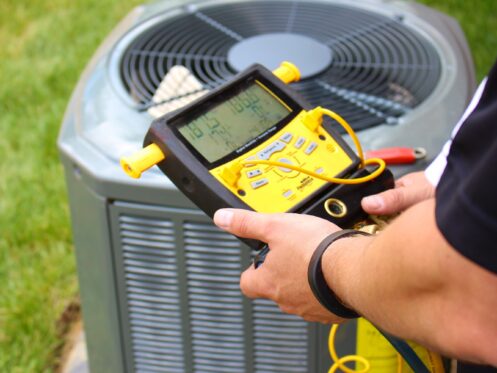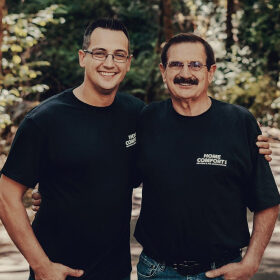Making sure that an air conditioner will survive the peak of summer cooling demand is an important job here in Oregon. Folks who want their systems to run smoothly know that preparation and maintenance are key. Here is a look at the steps you need to take throughout the year to ensure that your HVAC system will be ready for summer’s peak.
Filter Replacements
Filters can seem surprisingly minor as parts of an air conditioner. However, a dirty filter can easily shave 10% or more off your AC’s performance. Worse, that added strain can shorten the service life of your AC system, potentially leading to a breakdown at the absolute worst time during a summer heat wave.
The upside is that you can easily handle filter replacements yourself. Typically, an AC system has one or two filters largely aimed at keeping large particulate matter out of the system. If your HVAC unit includes an indoor air quality (IAQ) system, then you should also make sure it gets filter replacement on schedule.
The standard filters on an HVAC system are usually due for replacement every three months. Pre-filters for IAQ setups also tend to follow a three-month schedule. More advanced filters like high-efficiency particulate air (HEPA) systems may need to be replaced every six months or so.
It is also a good idea to check filters once a month in the first year that you run your system. This ensures that you’ll catch any issues. Some high-demand households may need to replace standard filters as often as once a month. This is common in households with long-haired pets that shed a lot, for example.
Scheduled Tune-Ups
Regular AC maintenance also goes a long way toward keeping your system in top condition going into summer. Systems under ten years of age can typically get by with a once-a-year tune-up. However, older systems may require semiannual tune-ups. Some that are in high-demand environments may even require tune-ups every three months.
For the sake of smooth operation during Oregon’s hot summers, it is best to schedule an AC tune-up for the end of March and no later than the start of May. This ensures that your system will get the attention it needs before the weather starts to really heat up.
A tune-up should cover multiple parts of the system. Our technicians typically connect to the HVAC control board to see if it’s reporting any error codes. We will then test communication between the thermostat and the control board. Likewise, we will assess the thermostat to make sure it’s properly detecting the temperature.
Our team also performs basic maintenance. We lubricate moving parts, such as blower motors and dampers, to ensure they don’t experience too much friction. We also test the pressure in the refrigerant line to verify that there aren’t any leaks. In addition, we will check for any spots of oil that might indicate where lubricant from the refrigerant lines could be leaking.
We like to clean the coils on the condenser and evaporator with professional-grade products. If a customer maintains a semiannual schedule, we may prefer to do the outside work cleaning the coils in the fall to ensure that dead leaves, grass clippings, and other debris don’t accumulate. The goal is to keep the heat exchange between the AC and the outside air as efficient as possible. This reduces the risk that the system will ice over, and it also tends to extend system life.
Our technicians perform a visual inspection as well. We will search for spots where wires and fittings might be loose. Also, we look for signs of physical damage, such as a dent where a stone thrown from a lawn mower might’ve hit a condenser coil.
Once we’re happy with the overall tune-up, we will run the system and see how well it performs. We are checking for issues like short cycling that could indicate that a major component like a compressor or capacitor has failed. If we encounter such issues, we will replace those components and then retest the AC.
This is also a good time to see how the thermostat settings are working. If they need to be tuned, we will adjust them so the temperature sensed by the thermostat is as close as possible to the actual conditions in your house. You may also want to check the programmed settings on the thermostat at this time to confirm they still match your needs.
Expected Benefits
An AC that goes without an annual tune-up will usually suffer about a 5% to 10% loss of efficiency each year. The loss of efficiency can be dramatically worse if a failing component is neglected. Systems with failing compressors or blower motors can see up to 50% efficiency losses or even just quit working entirely.
Fall Maintenance
Fall maintenance is a good way to take even better care of your HVAC system. Particularly, it is a good idea to decommission the AC system once the summer heat has ended. Our cooling service technicians can clean exterior coils, check for common issues, turn off components, and even cover exterior parts. This reduces the odds that debris from falling leaves will get into the system. Likewise, it discourages winter snowmelt from promoting corrosion.
Dehumidification
While air conditioners do provide limited dehumidification, you may want to consider adding a whole-house dehumidifier. Humid air has a higher thermal mass. This means that every unit of moist air requires significantly more energy to cool. A dehumidifier keeps the air in an optimal range where it improves AC efficiency, keeps your skin moist, and doesn’t promote mold growth. Lower humidity levels also discourage internal corrosion in HVAC systems.
IAQ Systems
Clean air also tends to be more efficient in cooling. Indoor air quality (IAQ) systems can clean the air of pollution, pollen, dander, mold spores, bacteria, and debris that can all interfere with your AC’s operation. A good IAQ setup prevents dirt from collecting in the HVAC system. This keeps filters and components cleaner, ensuring better heat exchange. That means lower electricity bills and a longer system life.
Upgrading to a Higher SEER
If your HVAC system is nearing the end of its expected lifespan, you may want to look at upgrades. One of the best upgrades is to adopt a high-efficiency system. The Seasonal Energy Efficiency Ratio (SEER) grades how well an AC performs, with a higher number being better. Minimally, an AC should have a SEER of 14, but some options reach 25 or higher. We strongly recommend at least a 16-SEER system as part of a new installation.
Home Comfort Inc. has been in business since 1954. We handle work for both residential and commercial HVAC customers, including installations, repairs, and maintenance. Customers can also request emergency services 24/7. We employ NATE-certified technicians, and our company is licensed. Our team works on systems from top manufacturers in the HVAC industry like Honeywell and Lennox, and we are experienced in ductless mini-splits as well.
If you are located in Dallas, OR or the surrounding area and want to know that your AC will perform smoothly this summer, reach out to Home Comfort Inc. today.

